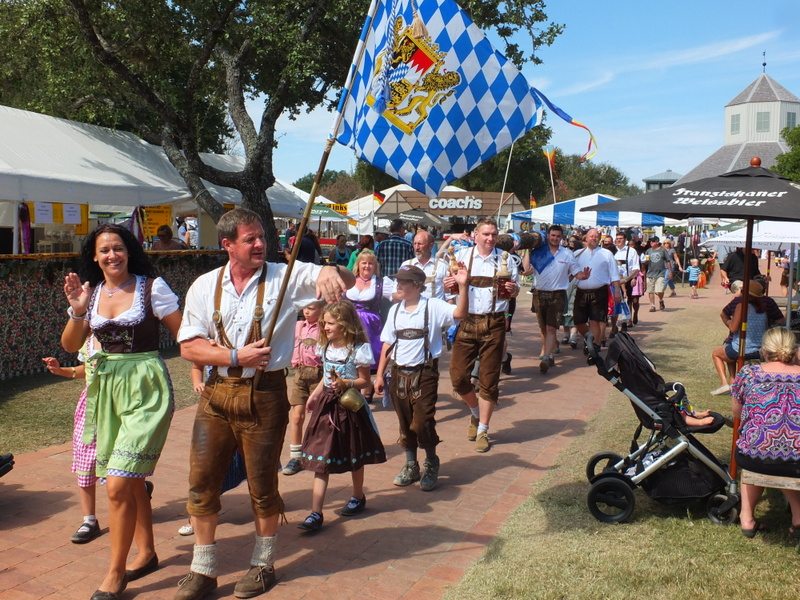 The small Texas town of Fredericksburg has a reputation for embracing and celebrating its German cultural heritage. Likewise, its annual three-day Oktoberfest event is recognized by several sources (Oktoberfestbeerfestivals.com,Realbeer.com, and citj.io among them) as among the best to be found in North America. I was curious about this place and event. I am a longtime admirer of German culture and beer having had the opportunity to live in Germany for several years. A Texas roadtrip and a desire to meet up with old friends from Houston led to a visit to Fredericksburg and its Oktoberfest.
The small Texas town of Fredericksburg has a reputation for embracing and celebrating its German cultural heritage. Likewise, its annual three-day Oktoberfest event is recognized by several sources (Oktoberfestbeerfestivals.com,Realbeer.com, and citj.io among them) as among the best to be found in North America. I was curious about this place and event. I am a longtime admirer of German culture and beer having had the opportunity to live in Germany for several years. A Texas roadtrip and a desire to meet up with old friends from Houston led to a visit to Fredericksburg and its Oktoberfest.
 Fredericksburg is named after Prince Frederick of Prussia, a benefactor of the original community. Founded in 1846, it co-existed with the commanches in the hilly country in what is now central Texas. The “Texas-German” dialect originated here from the refusal of the settlers to learn English. My reading of histories suggest that these settlers were immigrants from Germany who were fleeing political and economic issues of the times. An organization named the Mainzer Adelsverein supported this movement of people with the goal of “establishing a new Germany on Texas soil.”
Fredericksburg is named after Prince Frederick of Prussia, a benefactor of the original community. Founded in 1846, it co-existed with the commanches in the hilly country in what is now central Texas. The “Texas-German” dialect originated here from the refusal of the settlers to learn English. My reading of histories suggest that these settlers were immigrants from Germany who were fleeing political and economic issues of the times. An organization named the Mainzer Adelsverein supported this movement of people with the goal of “establishing a new Germany on Texas soil.”
 Now days, Fredericksburg is a town of about 10,000 people that is situated between Austin and San Antonio. Each of these cities is about an hour away making the town an attractive weekend roadtrip. In addition to the German cultural attraction, this is an area of wineries and is the home-region of President Lyndon Baines Johnson (LBJ).
Now days, Fredericksburg is a town of about 10,000 people that is situated between Austin and San Antonio. Each of these cities is about an hour away making the town an attractive weekend roadtrip. In addition to the German cultural attraction, this is an area of wineries and is the home-region of President Lyndon Baines Johnson (LBJ).
Fredericksburg celebrated its 35th annual Oktoberfest event in 2015 at its downtown MarktPlatz. Multiple stages of “oompah” music, bier tents featuring an impressive selection of taps, many food options, an artisans’ tent and plenty of Texas gemutlichkeit were all part of the fun. An estimated 20,000 people attend the three day event held on the first weekend in October each year. Single and multiple day admission tickets are sold — I purchased a three-day ticket for $16 and, after many tries, we found a nice place to stay in town that was walking distance to the event. Food and drink purchases are separate from the admission.
Following are images from the Oktoberfest event. Captions, when provided, appear above the related image(s) ….
German food offerings (some were more authentic renderings than others) included bratwursts, currywursts, German tacos, schnitzel plates, Pfeffernusse, potato pancakes, pretzels, German potato salad, red cabbage, and sauerkraut. There were alot of non-German food choices as well ….
I was impressed with the substantial beer options. Eighteen different German beers were on tap including Hofbrau, Spaten, Hacker-Pschorr, and Paulaner Oktoberfest biers from Munich. In addition there were 23 Texas craft beers on tap, and 23 other craft beers from breweries outside of Texas. In all there were 15 different Oktoberfest beers (marzens) on tap. The beer operation within the festival was impressive — separate banks of taps served each of the three beer tents.
There were no standard pop or rock cover bands here … all of the music and entertainment reflected German and central-European heritage. More than 25 different bands and groups performed in the three beer tents and one other venue. They carried names like Oma & the Oompahs, the Tubameisters, Chris Rybak the Polka Cowboy, Ennis Czech Boys, Havlak Batla Polka Time Band, Czech Melody Masters, Schuhplattlers, Yodel Blitz, and the Polkamatics ….



 Audience participation was invited in a couple of beer-related competitions …. one involved teaming up for a race to down a liter of beer …
Audience participation was invited in a couple of beer-related competitions …. one involved teaming up for a race to down a liter of beer …



 Another contest was a feat of strength and endurance involving hoisting and holding a half-liter of beer …
Another contest was a feat of strength and endurance involving hoisting and holding a half-liter of beer …
Beer is served in disposable plastic cups which some people could not resist turning into building projects ….
Photo Credits:
Der LindenBaum by Fbgtex2. Licensed under Public Domain via Commons
Bilingual street sign in Fredricksburg Texas” by Pete Unseth – Own work. Licensed under CC BY-SA 4.0 via Commons







































Leave a Reply